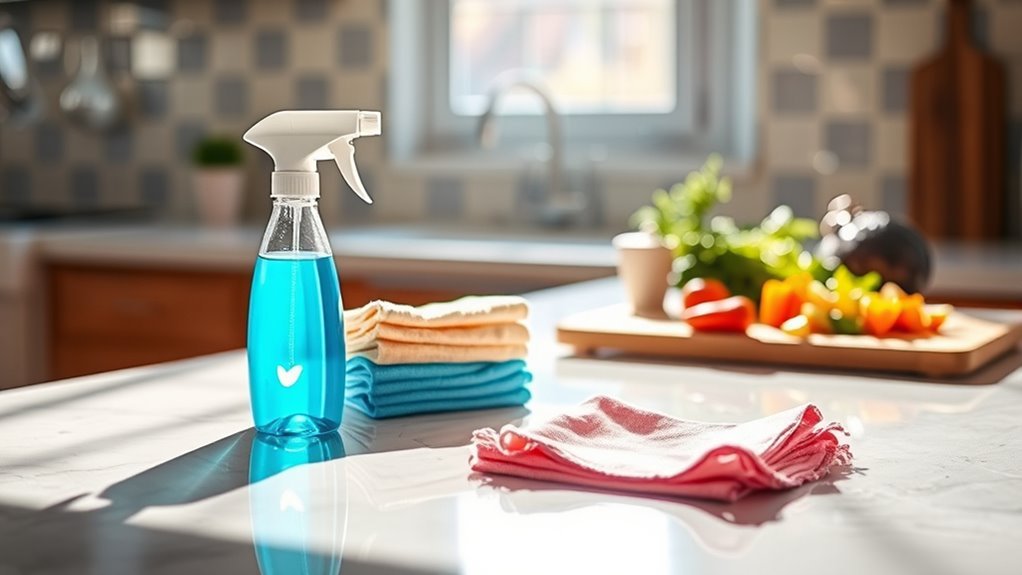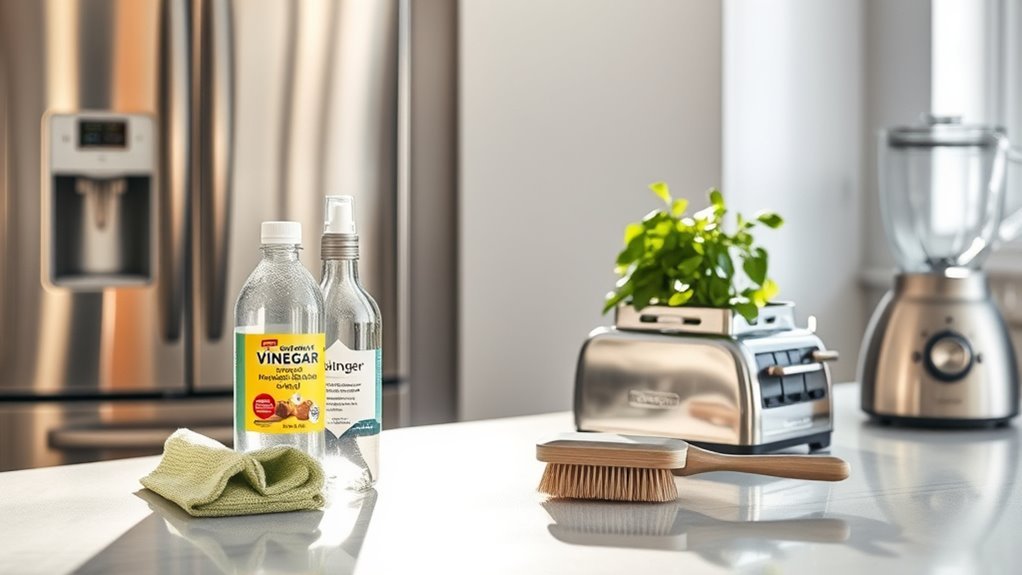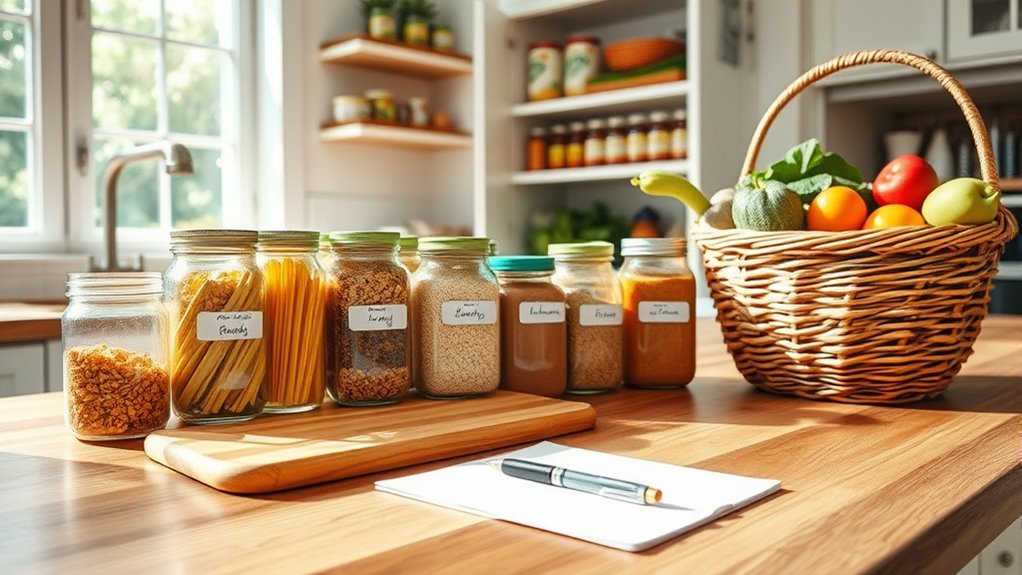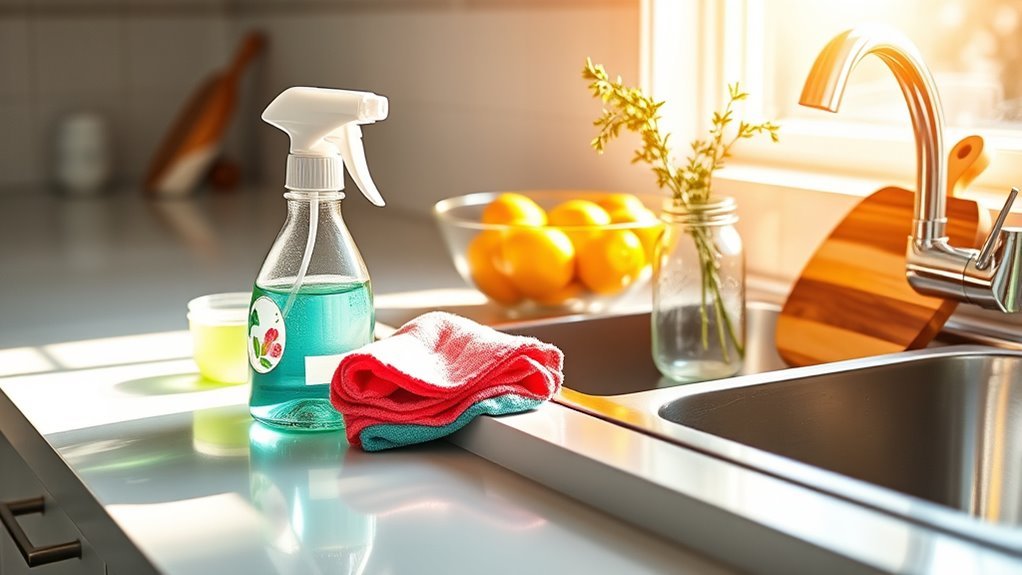Daily Maintenance Tips for Kitchen
You can keep your kitchen running smoothly by wiping and sanitizing surfaces daily to reduce bacteria and dirt. Organize your pantry by grouping items and labeling containers for easy access. Check appliances frequently—clean refrigerator coils and wipe stove spills promptly. Sort waste into recyclables, compost, and trash to avoid odors and pests. Keep utensils tidy and in good condition by storing and drying them properly. Stick to these habits, and you’ll find plenty more ways to enhance your kitchen’s efficiency and cleanliness.
Cleaning and Sanitizing Surfaces

Although cleaning and sanitizing surfaces might seem similar, they serve different purposes: cleaning removes dirt and debris, while sanitizing reduces harmful bacteria to safe levels. When you tackle kitchen surfaces, understanding surface materials is essential. For example, use gentle cleaners on wood to avoid damage, but you can apply stronger sanitizing techniques on stainless steel or laminate. After cleaning, apply a proper sanitizer—such as a diluted bleach solution or alcohol-based spray—to kill bacteria effectively. Always let the sanitizer sit for the recommended time to maximize its effect. Remember, sanitizing doesn’t replace cleaning; it complements it by further reducing risks. By mastering these practical steps, you gain freedom from worries about contamination, ensuring your kitchen stays both spotless and safe every day.
Organizing Pantry and Cabinets
Keeping your kitchen surfaces clean and sanitized lays the groundwork for a healthier cooking environment, but maintaining order in your pantry and cabinets plays an equally important role. To maximize efficiency and freedom in your kitchen, focus on these key steps:
Clean surfaces are essential, but organized pantries and cabinets truly enhance kitchen efficiency and freedom.
- Use pantry labels to clearly mark containers and shelves. It simplifies finding ingredients quickly and keeps everything in its place.
- Optimize cabinet layouts by grouping items based on use—placing frequently used tools and spices within easy reach saves time and minimizes clutter.
- Regularly declutter and rotate pantry items, checking expiration dates to avoid waste and create space for fresher goods.
Maintaining Kitchen Appliances

When you regularly maintain your kitchen appliances, you guarantee they run efficiently and last longer. Start by cleaning your refrigerator coils every six months to boost energy efficiency and prevent overheating. Defrost your freezer when ice builds up more than a quarter-inch thick, ensuring appliance longevity. For your stove and oven, wipe spills promptly and check seals on oven doors to keep heat from escaping. Don’t forget to descale your kettle and coffee maker to prevent mineral buildup that reduces performance. Clean your dishwasher’s filter monthly to maintain proper drainage and efficient operation. By following these practical steps, you’ll not only extend appliance longevity but also save on energy costs, giving you more freedom from costly repairs or replacements. Stay proactive—it’s the key to a smoothly running kitchen.
Proper Waste Disposal and Recycling
You should start by sorting your kitchen waste into categories like recyclables, compostables, and trash to keep things organized. Composting organic materials not only reduces landfill waste but also provides nutrient-rich soil for your plants. Don’t forget to rinse and separate common containers like glass, plastic, and metal to make recycling more effective.
Sorting Kitchen Waste
Although sorting kitchen waste might seem tedious, it plays an essential role in reducing environmental impact and maintaining a clean cooking space. By mastering waste separation, you free yourself from clutter and contribute to a healthier planet. Here’s how to get started:
- Designate separate bins for recyclables, landfill waste, and items suitable for kitchen composting.
- Rinse containers to prevent odors and pests, keeping your kitchen fresh and hygienic.
- Label each bin clearly to simplify sorting and encourage consistent habits.
Composting Organic Materials
Sorting your kitchen waste sets the foundation for effective composting, which turns organic materials into nutrient-rich soil rather than sending them to landfills. When you collect kitchen scraps like fruit peels, coffee grounds, and vegetable trimmings, you’re ready to choose the right composting methods that suit your space and lifestyle. Whether you opt for a traditional bin, worm composting, or a tumbler, keeping a balance of greens (nitrogen-rich) and browns (carbon-rich) is key. Here’s a quick guide to help you get started:
| Kitchen Scraps | Suitable Composting Methods |
|---|---|
| Fruit & vegetable peels | Traditional bin, tumbler |
| Coffee grounds | Worm composting, traditional bin |
| Eggshells | Tumbler, traditional bin |
| Bread scraps | Worm composting, traditional bin |
Recycling Common Containers
When disposing of common kitchen containers, understanding how to recycle them properly can greatly reduce waste and environmental impact. You can extend the life of many containers by choosing to reuse containers or upcycle jars creatively. Here are three key tips to follow:
- Rinse and clean containers thoroughly to avoid contamination in recycling bins.
- Separate materials like glass, plastic, and metal according to your local recycling guidelines.
- Upcycle jars as storage for spices, leftovers, or small tools to minimize waste and add functionality.
Managing Kitchen Utensils and Tools
Because you use kitchen utensils and tools daily, keeping them organized and in good condition is essential for efficiency and safety. Start by creating a dedicated utensil storage system—drawer dividers or wall-mounted racks work well. This prevents clutter and makes each item easy to find. Implement tool labeling to speed up your routine; label drawers or containers clearly so you won’t waste time searching. Regularly inspect your utensils for wear or damage, addressing any issues promptly to maintain functionality. After use, clean and dry each tool thoroughly to avoid rust or bacterial growth. By managing your kitchen utensils and tools thoughtfully, you gain freedom from chaos and frustration, making cooking smoother and more enjoyable every day.
Checking and Restocking Supplies

How often do you check your kitchen supplies to guarantee you never run out of essentials? Regular inventory assessment is vital to maintain a smooth cooking routine and avoid last-minute store runs. By implementing a systematic supply rotation, you confirm older items are used first, reducing waste and keeping your pantry fresh.
Here’s a simple approach to stay on top of your supplies:
- Schedule weekly inventory assessments to track quantities and expiration dates.
- Practice supply rotation by moving older products forward and placing new stock behind.
- Create a restocking list based on your assessment to replenish only what’s needed.
This method helps you maintain freedom in your kitchen, assuring you’re always prepared without overstocking or scrambling for ingredients.
Häufig gestellte Fragen
How Often Should I Deep Clean My Kitchen Exhaust Hood?
Think of your kitchen exhaust hood as a castle’s guardian, tirelessly shielding you from smoky invaders. For ideal exhaust hood maintenance, you should deep clean it every 3 to 6 months, depending on your cooking frequency. This cleaning frequency guarantees grease buildup doesn’t weaken your fortress. If you cook daily or fry often, lean towards every 3 months. Regular care keeps your kitchen fresh and free, letting you enjoy culinary freedom without worry.
What Are the Best Plants for Improving Kitchen Air Quality?
If you want to boost your kitchen’s air purification, consider starting a small herb garden. Plants like basil, mint, and rosemary not only freshen the air but also add flavor to your meals. Snake plants and spider plants are great for filtering toxins. You’ll enjoy cleaner air and the freedom to pick fresh herbs whenever you like, making your kitchen both healthier and more inviting.
How Can I Prevent Mold Growth Behind Kitchen Appliances?
Think of mold prevention like guarding a fortress—moisture is the enemy trying to sneak in behind your appliances. To keep mold at bay, regularly perform appliance cleaning by pulling out your fridge and stove, wiping down hidden surfaces with a vinegar solution, and ensuring good airflow. Fix leaks promptly and use a dehumidifier if needed. Staying vigilant lets you maintain a fresh, mold-free kitchen without feeling trapped by endless chores.
What’S the Ideal Humidity Level for a Kitchen?
You’ll want to keep your kitchen’s humidity level between 30% and 50% to prevent mold and maintain comfort. Proper humidity control is key, and good kitchen ventilation plays a big role here. Using exhaust fans when cooking and opening windows when possible helps reduce moisture buildup. By managing these factors, you’ll create a healthier space that’s free from dampness and odors, giving you more freedom to enjoy your kitchen without worry.
How Do I Maintain Grout Between Kitchen Tiles?
Keeping grout between your kitchen tiles clean is like giving your floor a fresh breath. You’ll want to start with regular grout cleaning using a gentle brush and a mix of baking soda and water. After cleaning, don’t forget tile sealing—this acts as a shield, preventing stains and moisture from sneaking in. Reseal every six months to keep your grout looking sharp and your kitchen feeling open and inviting.






